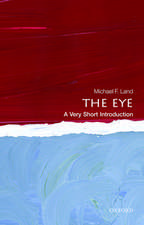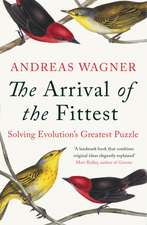Reticulate Evolution: Symbiogenesis, Lateral Gene Transfer, Hybridization and Infectious Heredity: Interdisciplinary Evolution Research, cartea 3
Editat de Nathalie Gontieren Limba Engleză Hardback – 21 iul 2015
Reticulate evolution brings forth a challenge to the standard Neo-Darwinian framework, which defines life as the outcome of bifurcation and ramification patterns brought forth by the vertical mechanism of natural selection. Reticulate evolution puts forward a pattern in the tree of life that is characterized by horizontal mergings and lineage crossings induced by symbiosis, symbiogenesis, lateral gene transfer, hybridization or divergence with gene flow and infective heredity, making the “tree of life” look more like a “web of life.” On an epistemological level, the various means by which hereditary material can be transferred horizontally challenges our classic notions of units and levels of evolution, fitness, modes of transmission, linearity, communities and biological individuality.
The case studies presented examine topics including the origin of the eukaryotic cell and its organelles through symbiogenesis; the origin of algae through primary and secondary symbiosis and dinoflagellates through tertiary symbiosis; the superorganism and holobiont as units of evolution; how endosymbiosis induces speciation in multicellular life forms; transferrable and non-transferrable plasmids and how they symbiotically interact with their host; the means by which pro- and eukaryotic organisms transfer genes laterally (bacterial transformation, transduction and conjugation as well as transposons and other mobile genetic elements); hybridization and divergence with gene flow in sexually-reproducing individuals; current (human) microbiome and viriome studies that impact our knowledge concerning the evolution of organismal health and acquired immunity; and how symbiosis and symbiogenesis can be modelled in computational evolution.
| Toate formatele și edițiile | Preț | Express |
|---|---|---|
| Paperback (1) | 947.18 lei 43-57 zile | |
| Springer International Publishing – 15 oct 2016 | 947.18 lei 43-57 zile | |
| Hardback (1) | 953.20 lei 43-57 zile | |
| Springer International Publishing – 21 iul 2015 | 953.20 lei 43-57 zile |
Preț: 953.20 lei
Preț vechi: 1162.43 lei
-18% Nou
Puncte Express: 1430
Preț estimativ în valută:
182.40€ • 190.92$ • 151.81£
182.40€ • 190.92$ • 151.81£
Carte tipărită la comandă
Livrare economică 31 martie-14 aprilie
Preluare comenzi: 021 569.72.76
Specificații
ISBN-13: 9783319163444
ISBN-10: 3319163442
Pagini: 340
Ilustrații: XII, 337 p. 61 illus., 54 illus. in color.
Dimensiuni: 155 x 235 x 24 mm
Greutate: 0.67 kg
Ediția:1st ed. 2015
Editura: Springer International Publishing
Colecția Springer
Seria Interdisciplinary Evolution Research
Locul publicării:Cham, Switzerland
ISBN-10: 3319163442
Pagini: 340
Ilustrații: XII, 337 p. 61 illus., 54 illus. in color.
Dimensiuni: 155 x 235 x 24 mm
Greutate: 0.67 kg
Ediția:1st ed. 2015
Editura: Springer International Publishing
Colecția Springer
Seria Interdisciplinary Evolution Research
Locul publicării:Cham, Switzerland
Public țintă
ResearchCuprins
Reticulate Evolution Everywhere.- Can We Understand Evolution Without Symbiogenesis?.- Symbiosis: Evolution’s Co-Author.- Novel Endosymbioses as a Catalyst of Fast Speciation.- Historical and Epistemological Perspectives on What Lateral Gene Transfer Mechanisms Contribute to Our Understanding of Evolution.- Plasmids: Histories of a Concept.- Symbiosis Between Non-Transferable Plasmids and Prokaryote Cells.- Host-Symbiont-Pathogen-Host Interactions: Wolbachia, Vector-Transmitted Human Pathogens and the Importance of Quantitative Models of Multipartite Coevolution.- Evolution of The Human Microbiome and Impacts on Human Health, Infectious Disease and Hominid Evolution.- Divergence-With-Gene-Flow: What Humans and Other Mammals Got Up To.- A Multiset Model of Multi-Species Evolution to Solve Big Deceptive Problems.
Notă biografică
Nathalie Gontier is a philosopher of science and an anthropologist. Her main research interests lie in evolutionary epistemology and non-Darwinian evolutionary theories, how the latter differ from the Modern Synthesis and how they can be implemented into the linguistic sciences and the overall sociocultural domain. As the founding director of the Lisbon Applied Evolutionary Epistemology Lab, she is affiliated to the Centre for Philosophy of Science at the Faculty of Science of the University of Lisbon, and financed by the Portuguese Fund for Science and Technology. Previous appointments were held at the Dutch Free University of Brussels (Belgium), the Konrad Lorenz Institute (Austria), and the American Museum of Natural History (USA). Her research has been sponsored by the American John Templeton Foundation, the European Marie Curie Actions and the Belgian Fund for Scientific Research Flanders. She is the founder and editor-in-chief of the Springer book series Interdisciplinary Evolution Research.
Textul de pe ultima copertă
Written for non-experts, this volume introduces the mechanisms that underlie reticulate evolution. Chapters are either accompanied with glossaries that explain new terminology or timelines that position pioneering scholars and their major discoveries in their historical contexts. The contributing authors outline the history and original context of discovery of symbiosis, symbiogenesis, lateral gene transfer, hybridization or divergence with gene flow, and infectious heredity. By applying key insights from the areas of molecular (phylo)genetics, microbiology, virology, ecology, systematics, immunology, epidemiology and computational science, they demonstrate how reticulate evolution impacts successful survival, fitness and speciation.
Reticulate evolution brings forth a challenge to the standard Neo-Darwinian framework, which defines life as the outcome of bifurcation and ramification patterns brought forth by the vertical mechanism of natural selection. Reticulate evolution puts forward a pattern in the tree of life that is characterized by horizontal mergings and lineage crossings induced by symbiosis, symbiogenesis, lateral gene transfer, hybridization or divergence with gene flow, and infective heredity, making the “tree of life” look more like a “web of life.” On an epistemological level, the various means by which hereditary material can be transferred horizontally challenges our classic notions of units and levels of evolution, fitness, modes of transmission, linearity, communities, and biological individuality.
The case studies presented examine topics including the origin of the eukaryotic cell and its organelles through symbiogenesis; the origin of algae through primary and secondary symbiosis and dinoflagellates through tertiary symbiosis; the superorganism and holobiont as units of evolution; how endosymbiosis induces speciation in multicellular life forms; transferrable and non-transferrable plasmids and how they symbiotically interact with their host; the means by which pro- and eukaryotic organisms transfer genes laterally (bacterial transformation, transduction and conjugation as well as transposons and other mobile genetic elements); hybridization and divergence with gene flow in sexually-reproducing individuals; current (human) microbiome and viriome studies that impact our knowledge concerning the evolution of organismal health and acquired immunity; and how symbiosis and symbiogenesis can be modelled in computational evolution.
Reticulate evolution brings forth a challenge to the standard Neo-Darwinian framework, which defines life as the outcome of bifurcation and ramification patterns brought forth by the vertical mechanism of natural selection. Reticulate evolution puts forward a pattern in the tree of life that is characterized by horizontal mergings and lineage crossings induced by symbiosis, symbiogenesis, lateral gene transfer, hybridization or divergence with gene flow, and infective heredity, making the “tree of life” look more like a “web of life.” On an epistemological level, the various means by which hereditary material can be transferred horizontally challenges our classic notions of units and levels of evolution, fitness, modes of transmission, linearity, communities, and biological individuality.
The case studies presented examine topics including the origin of the eukaryotic cell and its organelles through symbiogenesis; the origin of algae through primary and secondary symbiosis and dinoflagellates through tertiary symbiosis; the superorganism and holobiont as units of evolution; how endosymbiosis induces speciation in multicellular life forms; transferrable and non-transferrable plasmids and how they symbiotically interact with their host; the means by which pro- and eukaryotic organisms transfer genes laterally (bacterial transformation, transduction and conjugation as well as transposons and other mobile genetic elements); hybridization and divergence with gene flow in sexually-reproducing individuals; current (human) microbiome and viriome studies that impact our knowledge concerning the evolution of organismal health and acquired immunity; and how symbiosis and symbiogenesis can be modelled in computational evolution.
Caracteristici
Explains to non-experts how symbiosis, symbiogenesis, lateral gene transfer, hybridization and infectious heredity underlie reticulate evolution Includes glossaries that explain new terminology and timelines that situate major discoveries in their historical contexts Indexed in Book Citation Index Presents state of the art findings on how reticulate evolutionary mechanisms contribute to life’s evolution, what the theoretical and epistemological implications are for the standard evolutionary paradigm and how reticulate evolution contributes to health and disease Includes supplementary material: sn.pub/extras


















